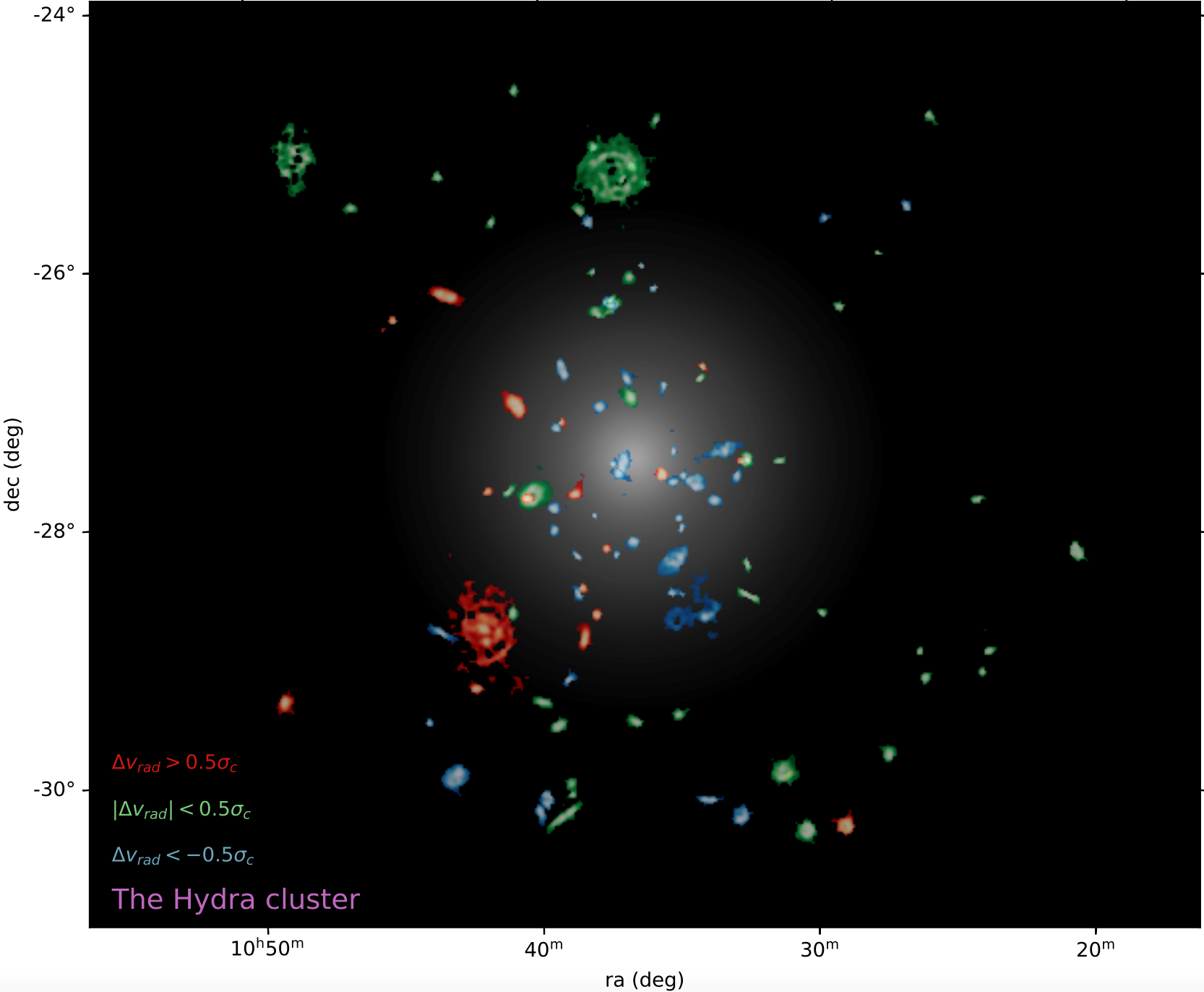Clusters of galaxies formed from the largest cosmological structures; they are the destination of galaxies traveling along the cosmic web, and serve as the best testbed for environmental effects that accelerate galaxy evolution. The Hydra cluster is the largest and most mature cluster of galaxies within 200 million light years. In a recent paper led by KIAA professor Jing Wang, the powerful new radio telescope ASKAP was used to map neutral hydrogen (HI) in the Hydra Cluster, revealing how cluster dynamics drives the evolution of infalling satellite galaxies. These discoveries are based on the widest survey of Hydra to date in HI, part of the WALLABY pilot survey with ASKAP.

Figure 1. WALLABY detected galaxies in the Hydra cluster. The frame is 5.5 the cluster radius in width and 4.5 times the cluster radius in height. The HI images are shown in different slices of velocity offset from the cluster center (∆vrad) around the X-ray halo of Hydra. This is also figure 1 of Wang et al. (2021). A similar image has been shown for the Virgo Cluster by Chung et al. (2009) using targeted HI observations.
Displayed in Figure 1, the whole field of view of the ASKAP HI image of Hydra is larger than 30 deg2, , or 150 times the area of the moon in the sky. The image fully covers the region out to more than twice the cluster radius, and detects all member and infalling satellites of Hydra (in total 115 galaxies) that have an HI mass above 108.2 M¤, or 18 times less massive than the HI disk of the Milky Way, revealing disk structures and intergalactic HI at moderate spatial resolution. This work is the first time that a massive cluster is homogeneously mapped in HI across a volume that extends far beyond the cluster region and with a sub-galactic scale resolution. This is also the first major HI study of a cluster beyond the local Virgo, Coma and A1367 clusters.
Based on this ASKAP HI data, Jing Wang and collaborators gain insights into the physics of cluster processing at a relatively early stage, when the infalling galaxies are still relatively HI rich. Theyquantify the instantaneous loss rate of HI in a galactic disk due to ram-pressure stripping from the hot intra-cluster gas where the HI disk is traveling through. They also quantify the level of ram-pressure and derive the mass of the strippable HI which is not sufficiently anchored to the disk by gravity against the ram pressure. They find that around 2/3 of the detected galaxies within 1.2 times the cluster radius may be under ram-pressure stripping, but the level of ram-pressure and thus the instantaneous HI loss rate differ widely among them. As a result, for at least half of the HI rich, infalling galaxies, ram-pressure stripping may accompany them for a long way after their infall: it may start in a galaxy at a cluster centric distance beyond the cluster radius, but only significantly deplete the whole HI disk when the galaxy gets close to the pericenter. These results highlight the potentially important role of weak ram-pressure stripping in shrinking the gas reservoir of star formation during satellite galactic evolution. The results were presented in the first science paper of WALLABY pilot survey (Wang et al. 2021).
Previous studies concluded that the strong ram-pressure stripping, which occurs near the core region of a cluster, can quickly deplete the HI of a satellite galaxy within a short time of several tens million years (in contrast, the HI in an unperturbed star-forming galaxy can typically sustain the current level of star formation rate for 100 times longer!). But the role of weak ram-pressure before galaxies reaching the cluster core regions has remained uncertain. Assessing the significance of weak ram pressure stripping, among many other mechanisms working at the same time, requires resolved HI distribution to derive the fraction of HI strippable by ram-pressure, a full census of the satellite population to ensure statistical representativeness, and sampling all the way beyond the cluster radius to fully capture the infall process of satellites into the cluster. These three requirements are only achieved simultaneously now by this ASKAP HI image of Hydra. ASKAP has observed another 2 clusters in the polit survey of WALLABY, among which the NGC 4636 group is also a target of the FAST-ASKAP synergy survey (led by Jing Wang). The study introduced here highlight the exciting science that can be done with HI data from new radio telescopes, including FAST, ASKAP, MeerKAT, ngVLA and SKA.
ASKAP1 (Australian Square Kilometre Array Pathfinder) is the fastest survey telescope at the frequency of 1.4 GHz. It is a synthesis array consisting of 36 dish antennas, each 12m in diameter, spread out in two dimensions with baselines up to 6km. Its large field of view and fast survey speed attribute to the phased array feed (PAF) technology, which was winner of the Engineers Australia's national Engineering Excellence Award in 2013, and The Australian Innovation Challenge in 2014.
WALLABY2 (The Widefield ASKAP L-band Legacy All-sky Blind survey) is one of the two key surveys that are now running on ASKAP. It will observe three-quarters of the whole sky in the 21-cm line of HI at 30-arcsec resolution, thereby detecting and imaging the gas distribution in hundreds of thousands of external galaxies in the local Universe. Currently, WALLABY has entered the Pilot Survey, and full WALLABY is expected to start in fall of 2021.
Link to article:
https://doi.org/10.3847/1538-4357/abfc52
https://ui.adsabs.harvard.edu/abs/2021arXiv210413052W/abstract
Footnote:
1. https://www.atnf.csiro.au/projects/askap/index.html
2. https://wallaby-survey.org/